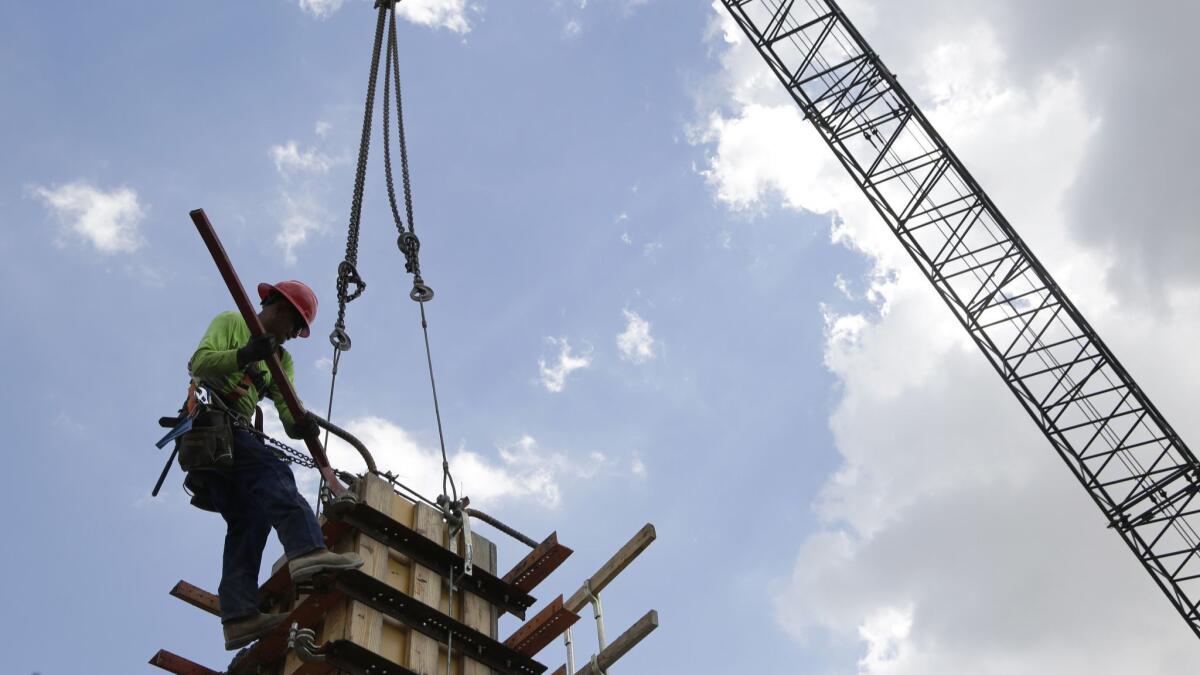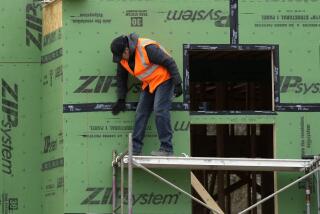Job growth remains solid, but workers are still waiting for a real jump in wages

- Share via
Reporting from WASHINGTON — The U.S. labor market remained in solid shape last month, adding 157,000 jobs while the unemployment rate ticked down to 3.9% and wage growth improved — although workers are still waiting for significant gains in their purchasing power because prices are also rising.
The July job report issued Friday by the Labor Department fell well short of analyst expectations and was down from 248,000 the previous month.
But the figures for May and June were revised upward by 59,000. That means the economy is still producing strong payroll gains, averaging 215,000 net new jobs a month, the best since 2015. The unemployment rate is near its lowest point since 2000.
At this stage in a record stretch of job growth that began in 2010, however, all eyes are on wages because they’ve been much slower to recover from the Great Recession.
The numbers there looked good in July, with a major caveat.
Average hourly earnings increased by 7 cents, or 0.3%, to $27.05. That was an improvement over a 4-cent gain in June.
Wages were up 2.7% for the 12 months that ended July 31, the same annual pace as in the previous month and an improvement over the sluggish 2% wage gains earlier in the recovery.
President Trump and Republicans have been trumpeting the stronger wage growth as a sign that their policies, particularly the large tax cuts that took effect Jan. 1, are working.
But they fail to note that prices have been rising along with wages. That means that, after adjusting for inflation, wage growth actually has slowed from its pace in 2015-16.
By one measure, it recently turned negative.
“‘America First’ means jobs first and wages second. When are corporations flush with cash from massive tax cuts going to give their employees a break?” said Chris Rupkey, chief financial economist at MUFG Union Bank in New York.
Consider that, while average hourly earnings are growing at an annual rate of 2.7%, the consumer price index for the 12 months that ended June 30 was up 2.9%. That means the purchasing power of Americans went down during that period.
A broader measure of inflation used by the Federal Reserve, based on total personal consumption expenditures, showed an annual rate of 2.2% for the 12 months that ended June 30. That means purchasing power has improved, but not much, in the last year.
The Labor Department tracks inflation-adjusted wages — known as real average hourly earnings. The most recent report, in June, showed a 0.1% increase in those earnings since May.
However, inflation-adjusted wage growth was flat in June compared with a year earlier for the second month in a row. Annual growth in real average hourly earnings was running about 2% in 2015 because inflation was much lower then.
“Obviously, we went through a period of remarkably low inflation, so that made modest wage gains look better,” said Mark Hamrick, senior economic analyst at financial information website Bankrate.com.
He said recent wage growth was disappointing and the lack of a significant uptick when adjusting for inflation is “a point of tension for many Americans,” even as economic growth boomed to a 4.1% annual rate in the second quarter of the year. That was the best since 2014.
Hearing Trump and other elected officials boast about wage growth that average people aren’t experiencing is causing a disconnect, Hamrick said.
“I think the American public’s being misled about the benefits of the tax cut being applied to wage gains where the data just don’t support that,” he said.
Trump made no comments Friday on the jobs report. But his reelection campaign issued a news release declaring that “Good News Continues for Jobs and Wages in Booming Trump Economy.”
Labor Secretary Alexander Acosta was more cautious. He said the data showed “continued strength” in the jobs market but also hinted at the wage concerns.
“It is clear that wage growth must increase, he said. “Further wage increases will add a great benefit to the American workforce.”
Sen. Martin Heinrich (D-N.M.) highlighted the slow inflation-adjusted pay gains, saying Friday’s report “provides the latest evidence that the Republican tax law has done little to raise real wages in this country.”
Federal Reserve Chairman Jerome H. Powell acknowledged last month during hearings on Capitol Hill that inflation-adjusted wage growth has been falling, although he said it was a positive sign that nominal wage growth was improving.
“Wages in general have been somewhat slow in moving up,” he told the House Financial Services Committee. “We understand that that really matters to people’s lives a lot.”
Some analysts note that employers are putting more money into healthcare coverage and other benefits, which increases overall worker compensation in ways that don’t show up in wage statistics.
But the Labor Department’s employment cost index, which takes into account wages and benefits, is up only slightly more than wages alone. For the 12 months that ended June 30, the index had increased 2.8%.
Cathy Barrera, chief economist for ZipRecruiter, the Santa Monica online jobs marketplace, said average hourly earnings don’t tell the whole story.
Wages rose much faster in the second quarter of the year for people in lower-paying jobs than for other employees, she said.
“Because many of the jobs that are being added to the labor market in recent months are at the lower end of the wage spectrum, that would tend to bring the average wage down,” Barrera said.
Still, the development is a positive sign because it indicates that younger Americans and those with less education who were staying on the sidelines are now entering the workforce, she said.
“I’d like to see stronger wage growth but that being said there are obviously a lot of different forces at play,” Barrera said.
UPDATES:
10:15 a.m.: This article was updated with comments from the Trump campaign, Labor Secretary Alexander Acosta, Sen. Martin Heinrich and Cathy Barrera of ZipRecruiter, as well as additional statistics.
7:40 a.m.: This article was updated with staff reporting and analysis.
This article was originally published at 5:30 a.m.
More to Read
Inside the business of entertainment
The Wide Shot brings you news, analysis and insights on everything from streaming wars to production — and what it all means for the future.
You may occasionally receive promotional content from the Los Angeles Times.











